https://github.com/ballerina-platform/module-ballerinax-hubspot.crm.engagements.calls
HubSpot CRM Engagements Calls API connector
https://github.com/ballerina-platform/module-ballerinax-hubspot.crm.engagements.calls
ballerina connectors hubspot
Last synced: 3 months ago
JSON representation
HubSpot CRM Engagements Calls API connector
- Host: GitHub
- URL: https://github.com/ballerina-platform/module-ballerinax-hubspot.crm.engagements.calls
- Owner: ballerina-platform
- License: apache-2.0
- Created: 2025-02-13T00:35:02.000Z (8 months ago)
- Default Branch: main
- Last Pushed: 2025-05-19T05:17:18.000Z (5 months ago)
- Last Synced: 2025-05-19T06:26:10.578Z (5 months ago)
- Topics: ballerina, connectors, hubspot
- Language: Ballerina
- Size: 4.03 MB
- Stars: 0
- Watchers: 47
- Forks: 2
- Open Issues: 0
-
Metadata Files:
- Readme: README.md
- License: LICENSE
- Codeowners: .github/CODEOWNERS
Awesome Lists containing this project
README
# Ballerina HubSpot CRM Engagements Calls connector
[](https://github.com/ballerina-platform/module-ballerinax-hubspot.crm.engagements.calls/actions/workflows/ci.yml)
[](https://github.com/ballerina-platform/module-ballerinax-hubspot.crm.engagements.calls/commits/master)
[](https://github.com/ballerina-platform/ballerina-library/labels/module%hubspot.crm.engagements.calls)
## Overview
[HubSpot](https://www.hubspot.com/) is an AI-powered customer relationship management (CRM) platform.
The `ballerinax/hubspot.crm.engagements.calls` connector offers APIs to connect and interact with the [Hubspot CRM Engagements Calls API](https://developers.hubspot.com/docs/guides/api/crm/engagements/calls) endpoints, specifically based on the [HubSpot REST API](https://developers.hubspot.com/docs/reference/api/overview).
## Setup guide
### Step 1: Create/login to a HubSpot developer account
If you already have a HubSpot Developer Account, go to the [HubSpot developer portal](https://app.hubspot.com/).
If you don't have an account, you can sign up for a free account [here](https://developers.hubspot.com/get-started).
### Step 2: Create a developer test account (Optional)
Within app developer accounts, you can create a [Developer Test Account](https://developers.hubspot.com/beta-docs/getting-started/account-types#developer-test-accounts) to test apps and integrations without affecting any real HubSpot data.
> **Note:** These accounts are only for development and testing purposes. In production, you should not use Developer Test Accounts.
1. Go to the `Test accounts` section from the left sidebar.
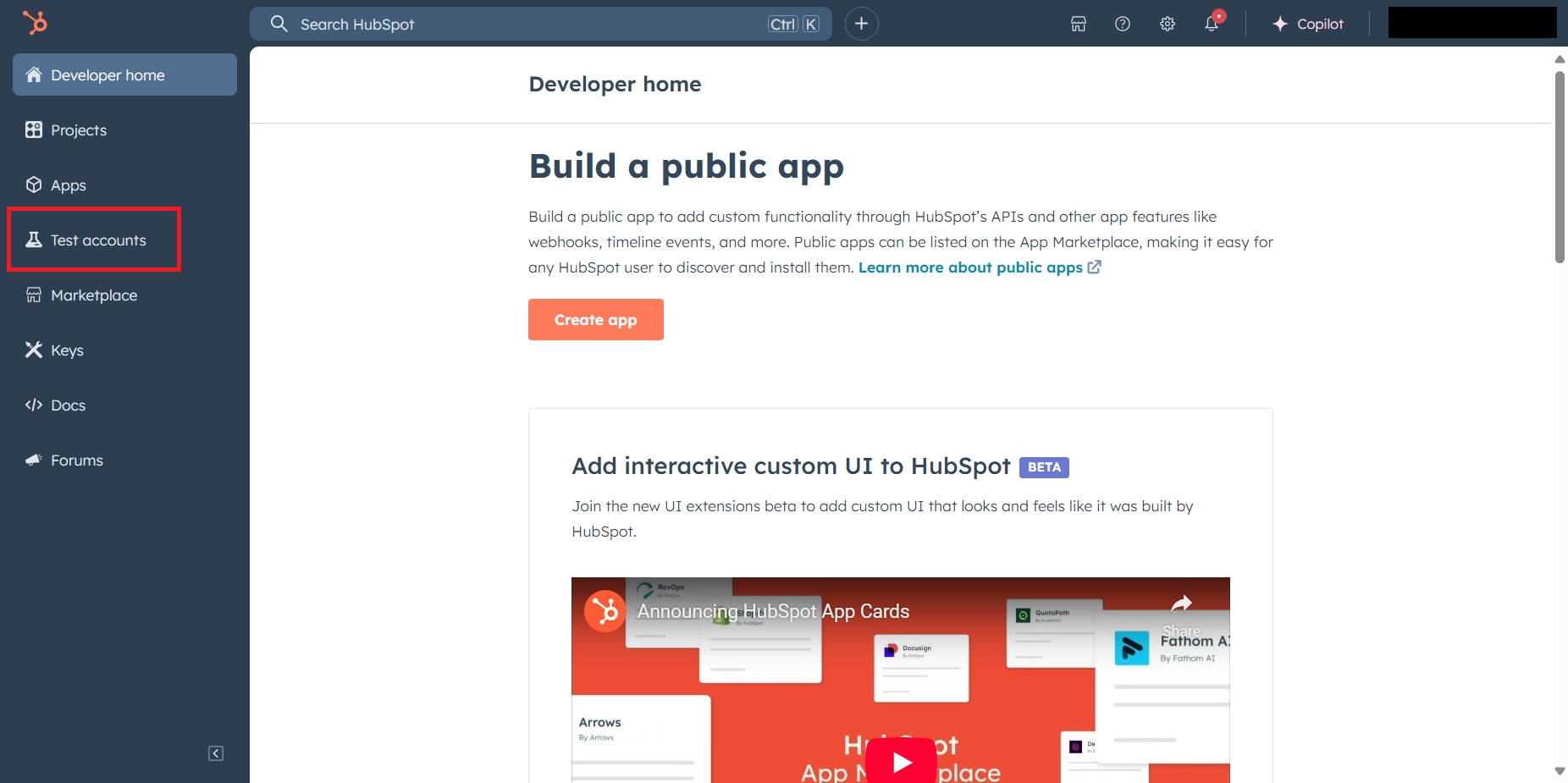
2. Click on the `Create developer test account` button on the top right corner.
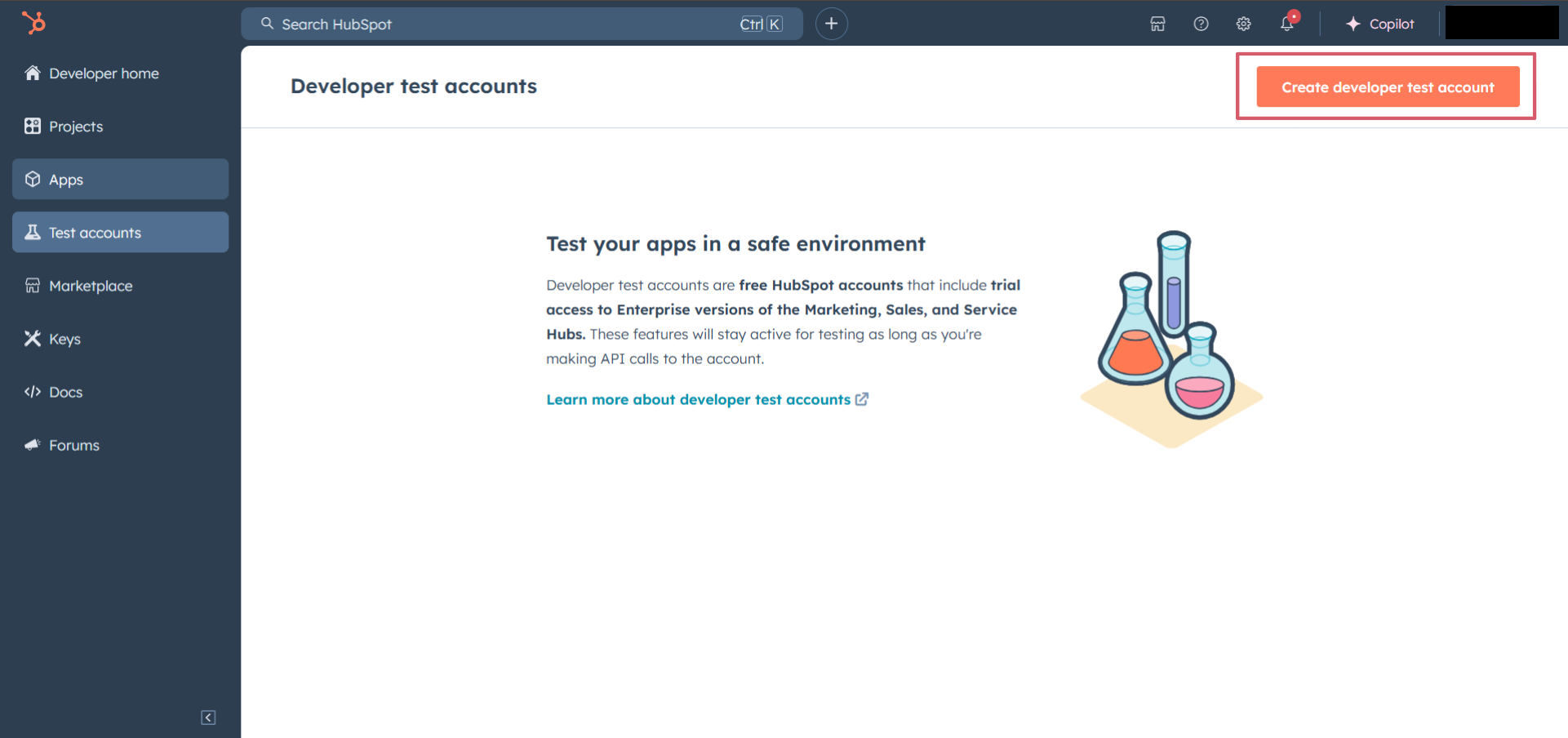
3. In the pop-up window, provide a name for the test account and click on the `Create` button.
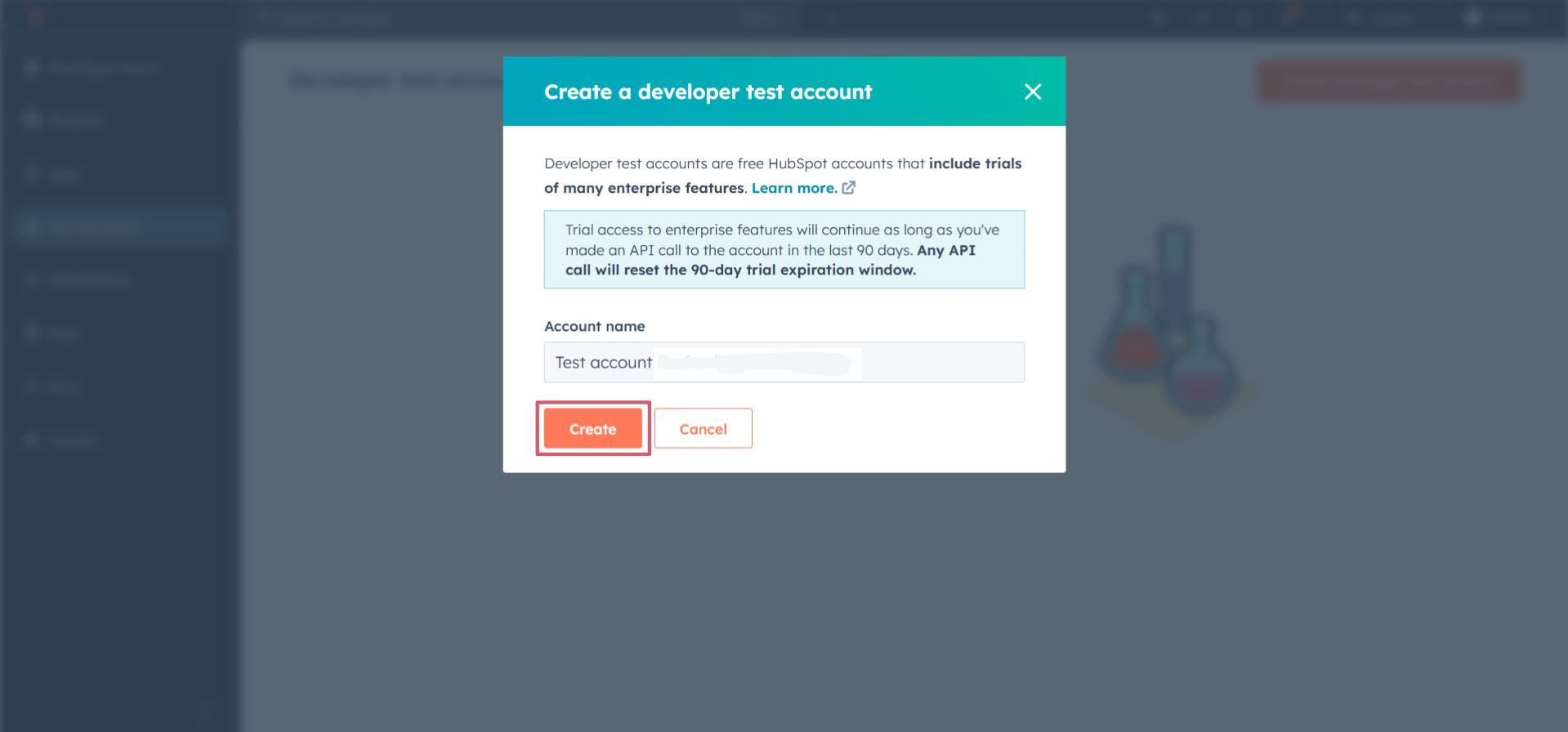
4. You will see the newly created test account in the list of test accounts.
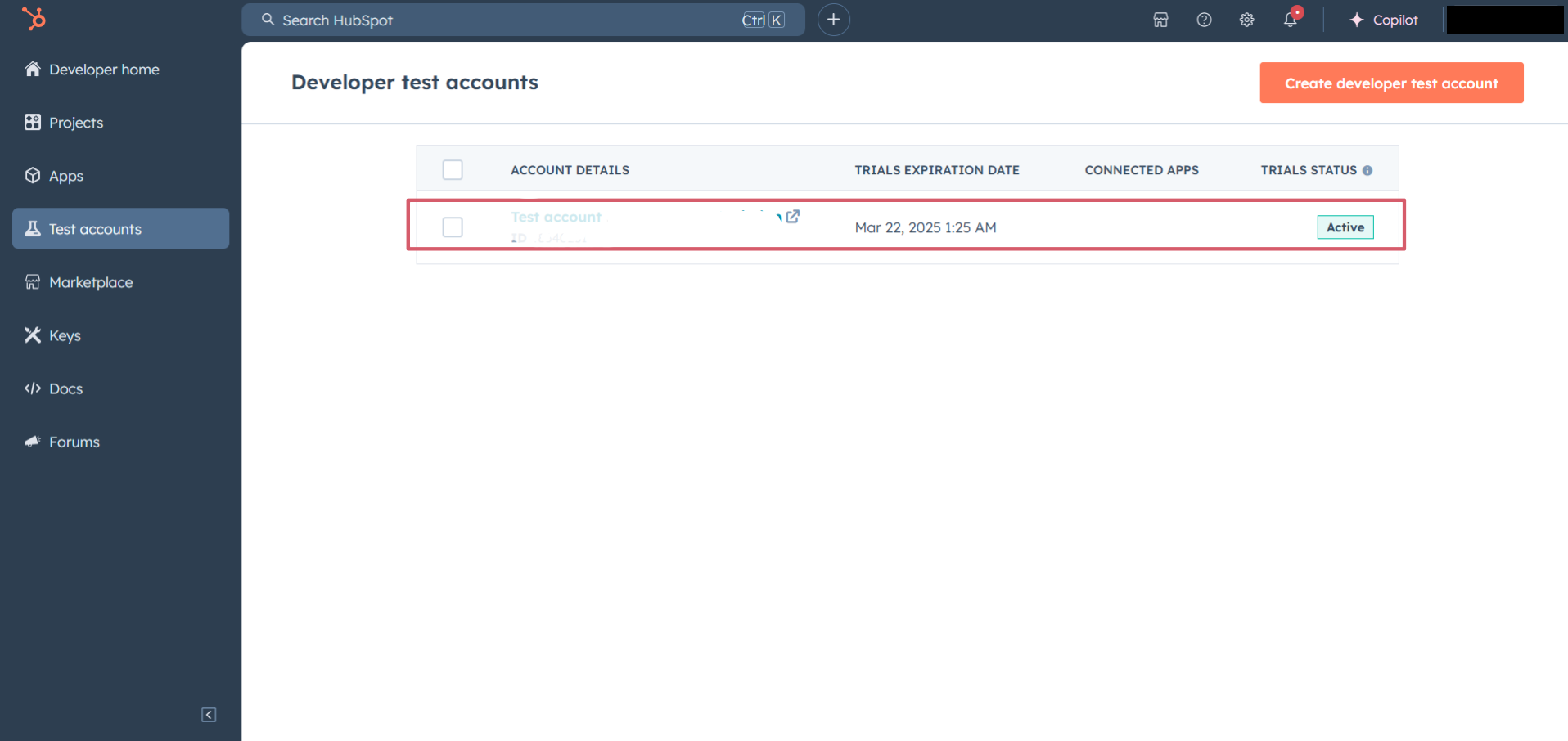
### Step 3: Create a HubSpot app
1. Now navigate to the `Apps` section from the left sidebar and click on the `Create app` button on the top right corner.
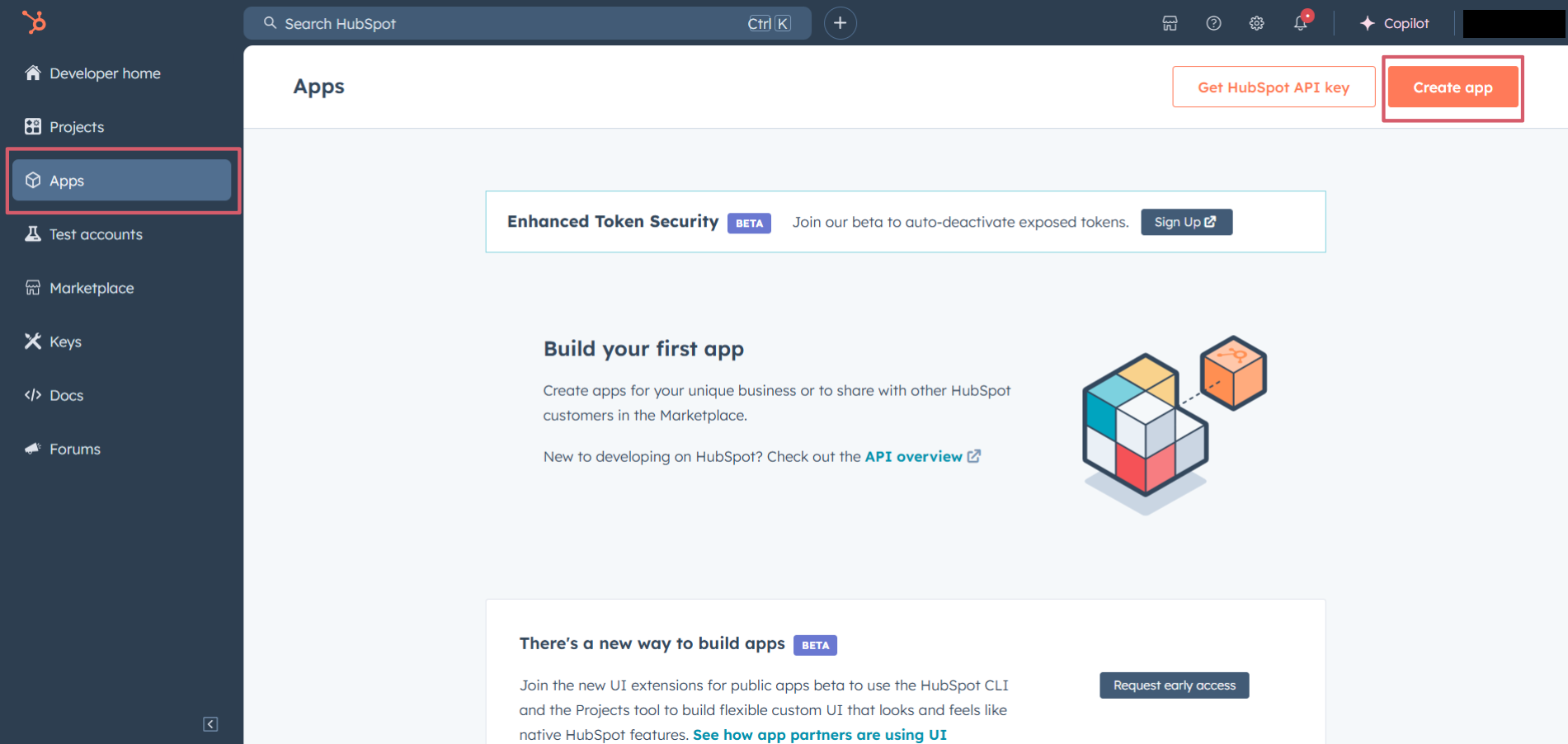
2. Provide a public app name and description for your app.
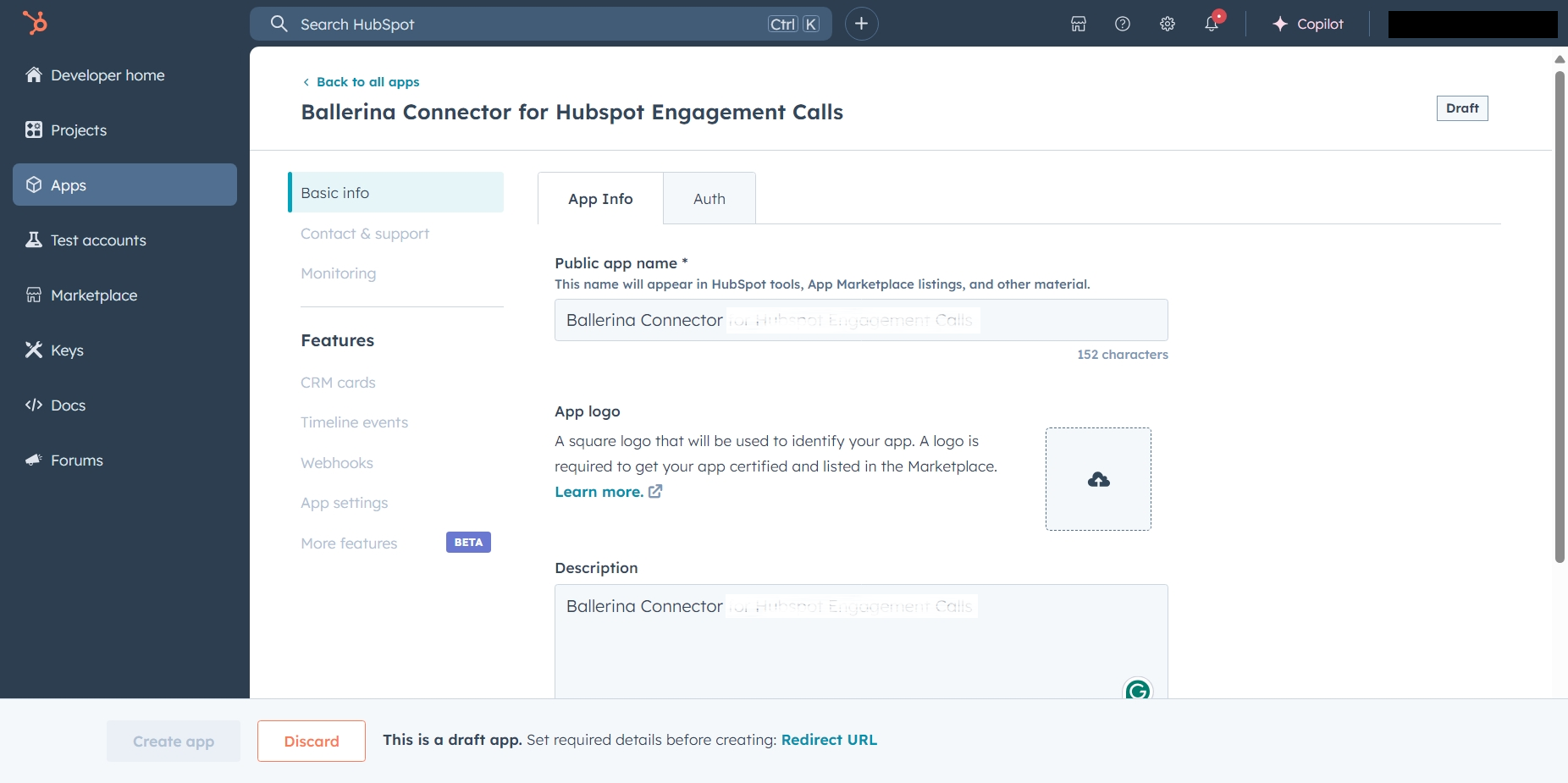
### Step 4: Set up authentication
1. Move to the `Auth` tab.
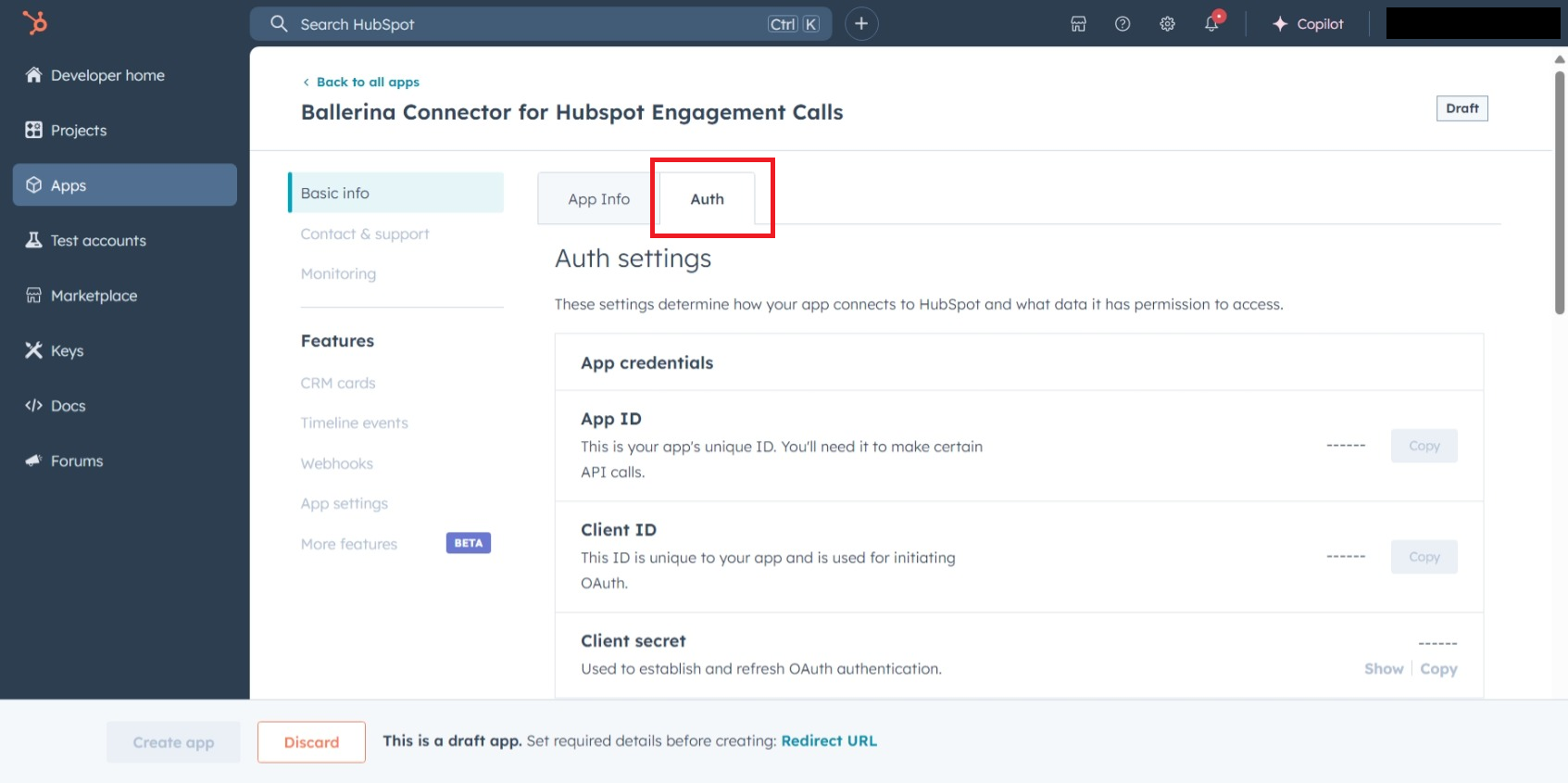
2. Then scroll down to the `Scopes` section and click on the `Add new scopes` button to add the scopes.
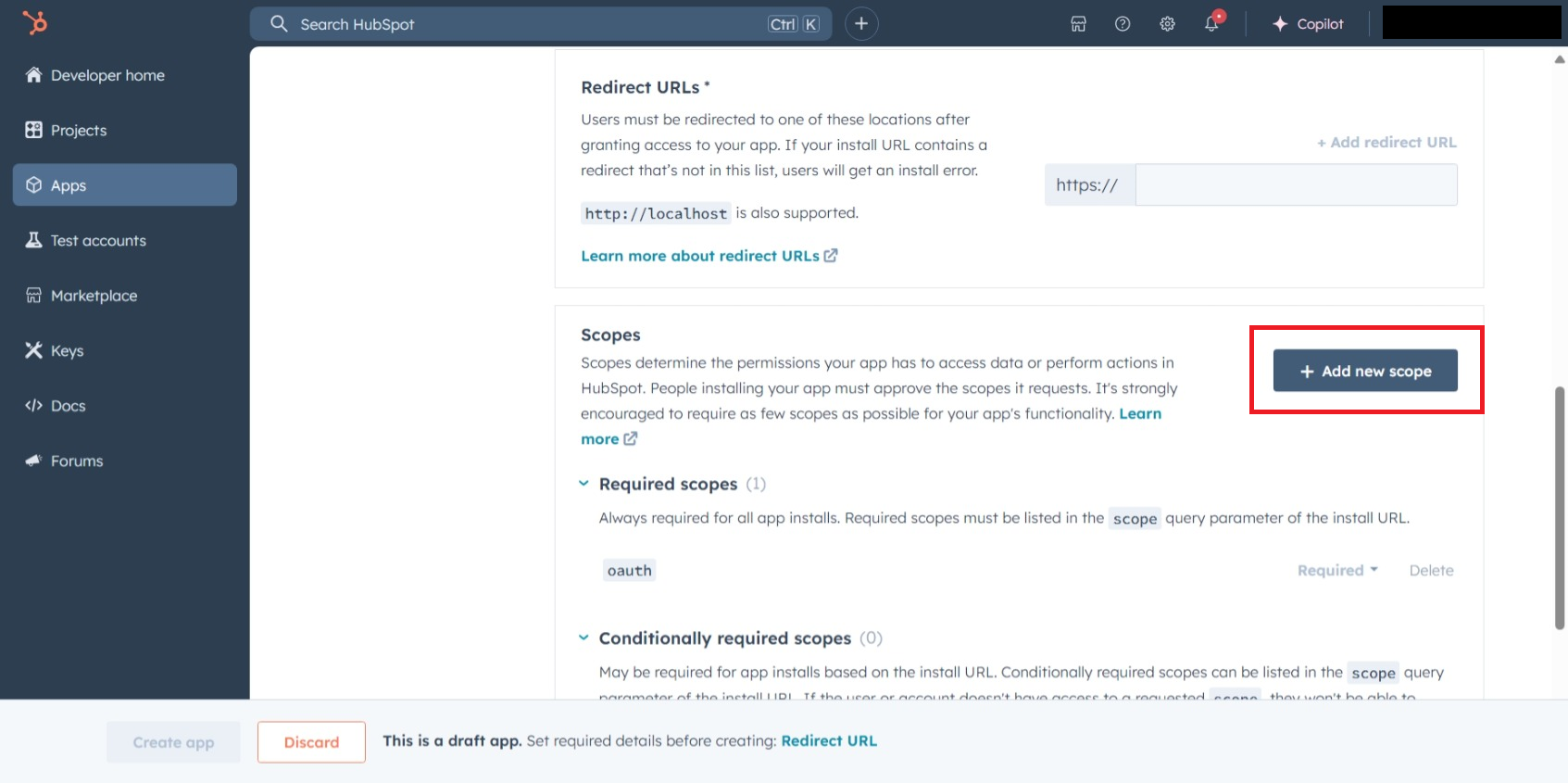
3. Add the following scopes and click on the `Update` button.
- `crm.objects.contacts.read`
- `crm.objects.contacts.write`
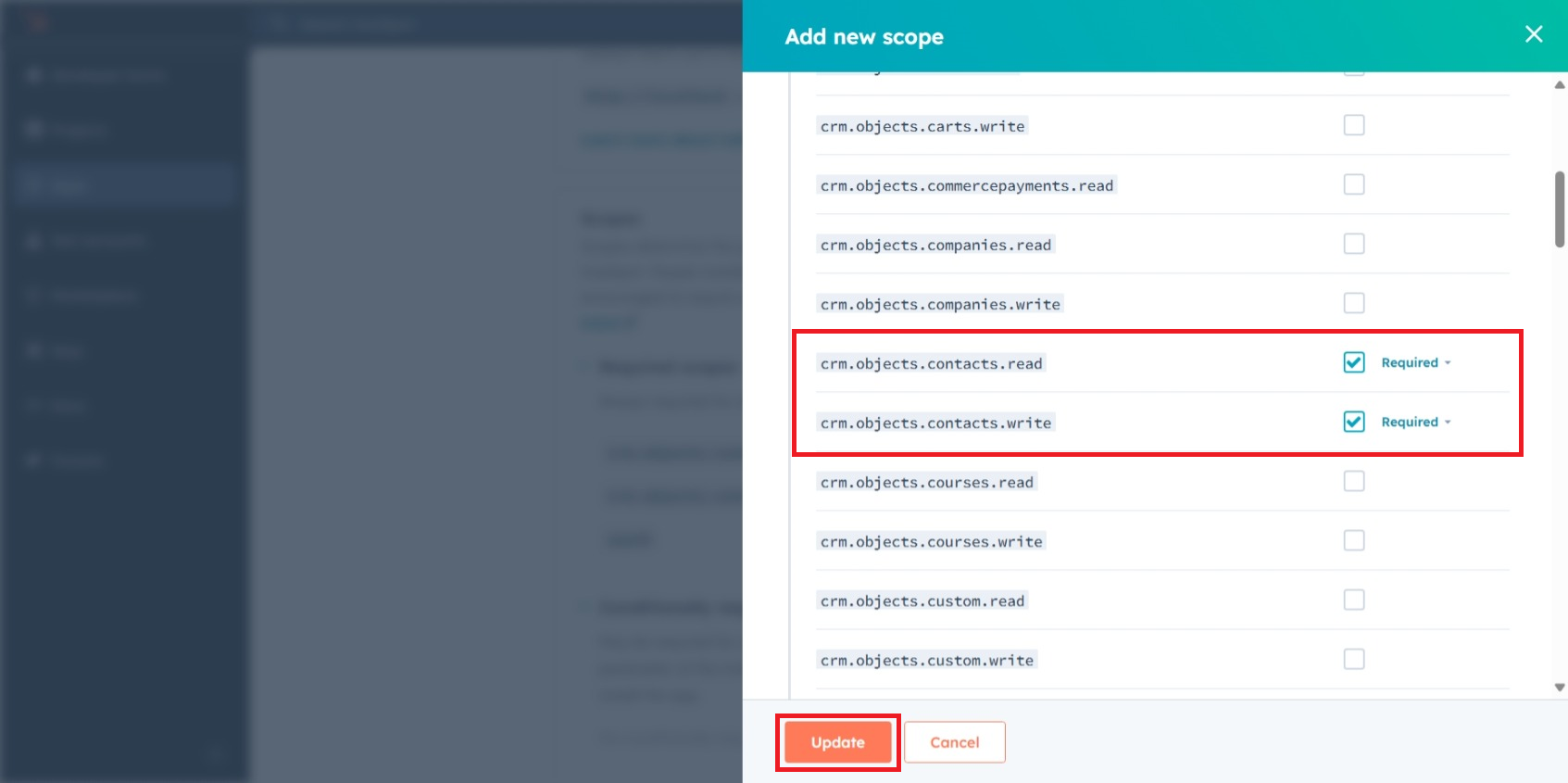
4. In the `Redirect URL` section, add the redirect URL for your app. This is the URL where the user will be redirected after the authentication process. You can use localhost for testing purposes. Then hit the `Create App` button.

### Step 5: Get the client ID and client secret
Navigate to the `Auth` tab and you will see the `Client ID` and `Client Secret` for your app. Make sure to save these values.
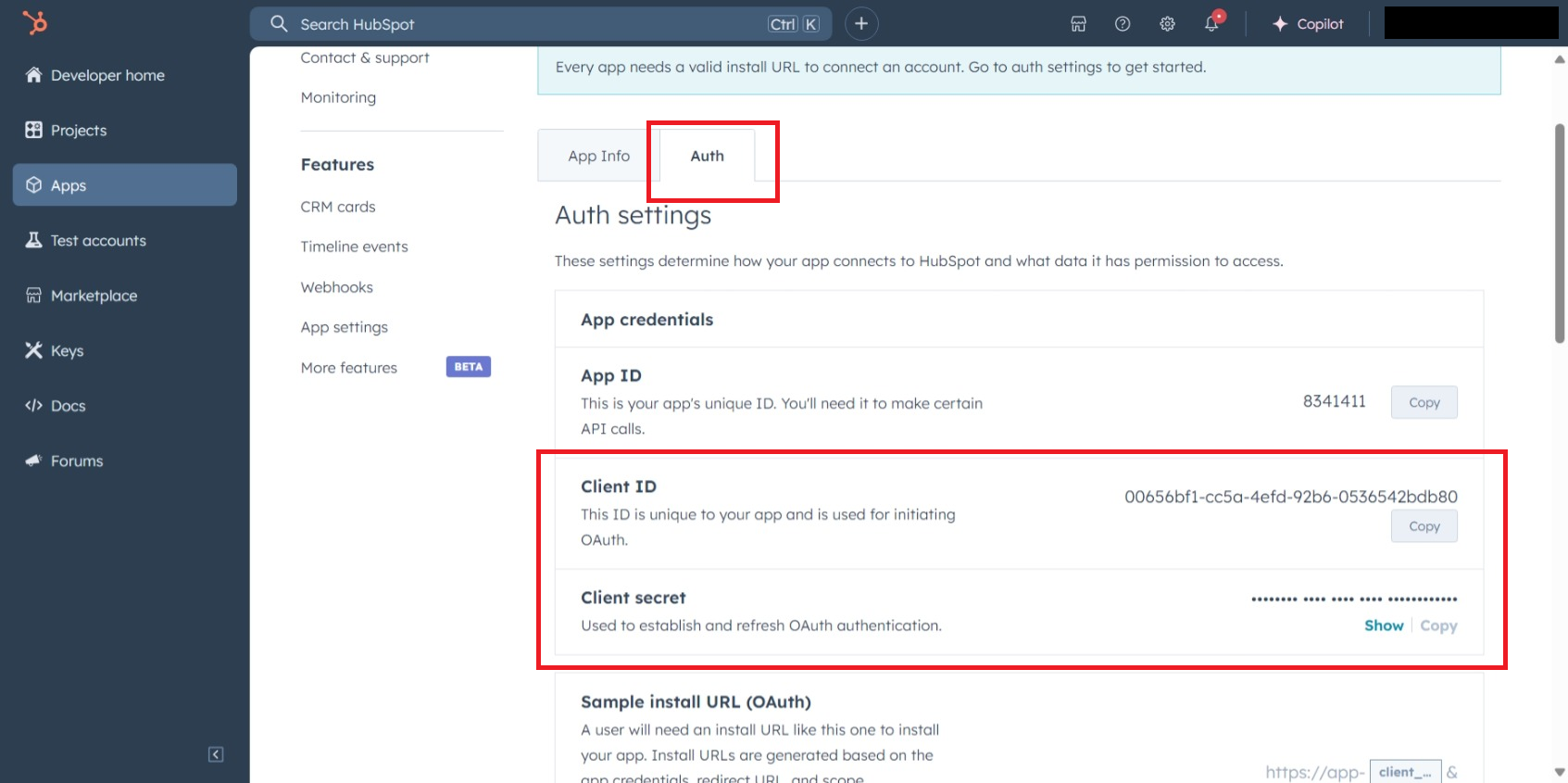
### Step 6: Set up authentication flow
Before proceeding with the Quickstart, ensure you have obtained the Access Token using the following steps:
1. Create an authorization URL using the following format:
```url
https://app.hubspot.com/oauth/authorize?client_id=&scope=&redirect_uri=
```
Replace the ``, ``, and `` with your specific values.
2. Paste it in the browser and select your developer test account to install the app when prompted.
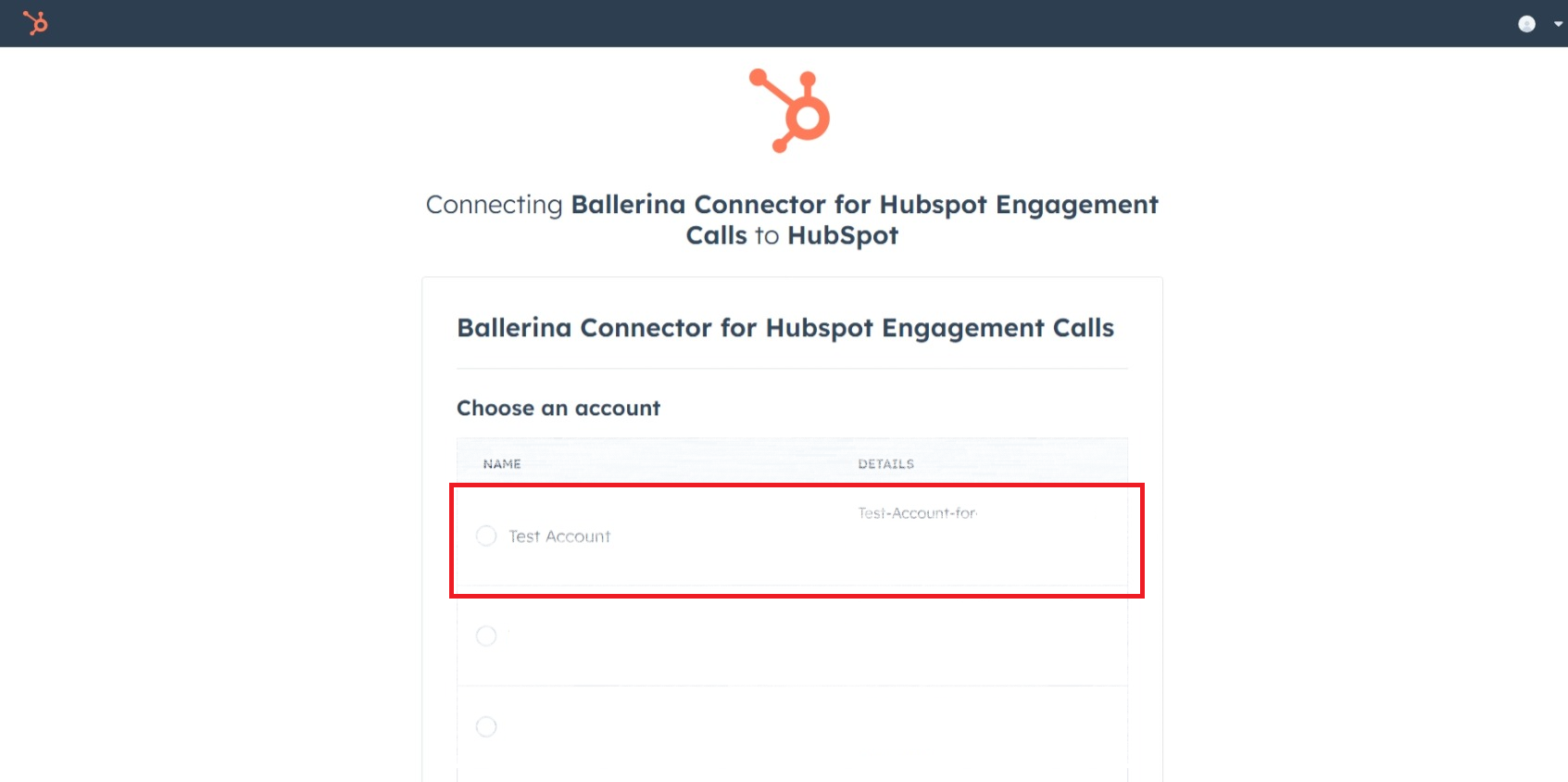
3. A code will be displayed in the browser. Copy the code.
4. Run the following curl command. Replace the ``, ``, and `` with your specific values. Use the code you received in the above step 3 as the ``.
- Linux/macOS
```bash
curl --request POST \
--url https://api.hubapi.com/oauth/v1/token \
--header 'content-type: application/x-www-form-urlencoded' \
--data 'grant_type=authorization_code&code=&redirect_uri=&client_id=&client_secret='
```
- Windows
```bash
curl --request POST ^
--url https://api.hubapi.com/oauth/v1/token ^
--header 'content-type: application/x-www-form-urlencoded' ^
--data 'grant_type=authorization_code&code=&redirect_uri=&client_id=&client_secret='
```
This command will return the access token necessary for API calls.
```json
{
"token_type": "bearer",
"refresh_token": "",
"access_token": "",
"expires_in": 1800
}
```
5. Store the access token securely for use in your application.
## Quickstart
To use the `HubSpot CRM Engagement Calls` connector in your Ballerina application, update the `.bal` file as follows:
### Step 1: Import the module
Import the `hubspot.crm.engagements.calls` module and `oauth2` module.
```ballerina
import ballerina/oauth2;
import ballerinax/hubspot.crm.engagements.calls as hscalls;
```
### Step 2: Instantiate a new connector
1. Create a `Config.toml` file and configure the obtained credentials in the above steps as follows:
```toml
clientId =
clientSecret =
refreshToken =
```
2. Instantiate a `OAuth2RefreshTokenGrantConfig` with the obtained credentials and initialize the connector with it.
```ballerina
configurable string clientId = ?;
configurable string clientSecret = ?;
configurable string refreshToken = ?;
OAuth2RefreshTokenGrantConfig auth = {
clientId,
clientSecret,
refreshToken,
credentialBearer: oauth2:POST_BODY_BEARER
};
ConnectionConfig config = {auth:auth};
final hscalls:Client hubspot = check new(config);
```
### Step 3: Invoke the connector operation
Now, utilize the available connector operations. A sample use case is shown below.
#### Read all Calls
```ballerina
public function main() returns error? {
hscalls:CollectionResponseSimplePublicObjectWithAssociationsForwardPaging pageOfCalls = check hubspot->/.get();
io:println("Calls: ", pageOfCalls);
}
```
#### Create a Call
```ballerina
public function main() returns error? {
hscalls:SimplePublicObjectInputForCreate payloadCreate = {
properties: {
"hs_timestamp": "2025-02-17T01:32:44.872Z",
"hs_call_title": "Support call",
"hubspot_owner_id": "12345", // Use existing owner ID
"hs_call_body": "Resolved issue",
"hs_call_duration": "3800",
"hs_call_from_number": "(857) 829 5489",
"hs_call_to_number": "(509) 999 9999",
"hs_call_recording_url": "example.com/recordings/abc",
"hs_call_status": "IN_PROGRESS"
},
associations: [
{
types: [
{
associationCategory: "HUBSPOT_DEFINED",
associationTypeId: 194
}
],
to: {
id: contactId
}
}
]
};
hscalls:SimplePublicObject responseCreated = check hubspot->/.post(payloadCreate);
string callId = responseCreated.id;
io:println("Call created successfully with ID: " + callId);
}
```
Refer to the [HubSpot CRM Association Documentation](https://developers.hubspot.com/docs/guides/api/crm/associations/associations-v4#call-to-object) to learn about associations and default association types. In this example, I used the association for 'call to contact,' which is 194.
Also, refer to the [HubSpot CRM Engagements Calls Documentation](https://developers.hubspot.com/docs/reference/api/crm/engagements/calls) to learn about the properties of a call in HubSpot CRM.
## Examples
The `HubSpot CRM Engagements Calls` connector provides practical examples illustrating usage in various scenarios. Explore these [examples](https://github.com/ballerina-platform/module-ballerinax-hubspot.crm.engagements.calls/tree/main/examples), covering the following use cases:
1. [Call for contacts](https://github.com/ballerina-platform/module-ballerinax-hubspot.crm.engagements.calls/tree/main/examples/call-for-contact) - This example demonstrate the operations on a single call such as creating, updating, and deleting, as well as getting a list of available calls and searching for a call by its content.
2. [Manage batch of calls for contacts](https://github.com/ballerina-platform/module-ballerinax-hubspot.crm.engagements.calls/tree/main/examples/manage-batch-of-calls) - This example demonstrate operations on a batch of calls such as creating, updating, and deleting, as well as getting calls by their ID.
## Build from the source
### Setting up the prerequisites
1. Download and install Java SE Development Kit (JDK) version 21. You can download it from either of the following sources:
- [Oracle JDK](https://www.oracle.com/java/technologies/downloads/)
- [OpenJDK](https://adoptium.net/)
> **Note:** After installation, remember to set the `JAVA_HOME` environment variable to the directory where JDK was installed.
2. Download and install [Ballerina Swan Lake](https://ballerina.io/).
3. Download and install [Docker](https://www.docker.com/get-started).
> **Note**: Ensure that the Docker daemon is running before executing any tests.
4. Export Github Personal access token with read package permissions as follows,
```bash
export packageUser=
export packagePAT=
```
### Build options
Execute the commands below to build from the source.
1. To build the package:
```bash
./gradlew clean build
```
2. To run the tests:
```bash
./gradlew clean test
```
3. To build the without the tests:
```bash
./gradlew clean build -x test
```
4. To run tests against different environments:
```bash
./gradlew clean test -Pgroups=
```
5. To debug the package with a remote debugger:
```bash
./gradlew clean build -Pdebug=
```
6. To debug with the Ballerina language:
```bash
./gradlew clean build -PbalJavaDebug=
```
7. Publish the generated artifacts to the local Ballerina Central repository:
```bash
./gradlew clean build -PpublishToLocalCentral=true
```
8. Publish the generated artifacts to the Ballerina Central repository:
```bash
./gradlew clean build -PpublishToCentral=true
```
## Contribute to Ballerina
As an open-source project, Ballerina welcomes contributions from the community.
For more information, go to the [contribution guidelines](https://github.com/ballerina-platform/ballerina-lang/blob/master/CONTRIBUTING.md).
## Code of conduct
All the contributors are encouraged to read the [Ballerina Code of Conduct](https://ballerina.io/code-of-conduct).
## Useful links
- For more information go to the [`hubspot.crm.engagements.calls` package](https://central.ballerina.io/ballerinax/hubspot.crm.engagements.calls/latest).
- For example demonstrations of the usage, go to [Ballerina By Examples](https://ballerina.io/learn/by-example/).
- Chat live with us via our [Discord server](https://discord.gg/ballerinalang).
- Post all technical questions on Stack Overflow with the [#ballerina](https://stackoverflow.com/questions/tagged/ballerina) tag.